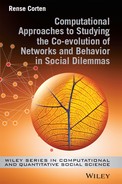Appendix B
The computer interface used for the experiment
This appendix describes the details of the computer interface used during the experiment described in Chapter 4. The interface was created using the z-Tree software (Fischbacher, 2007). Via this interface, subjects received information on the computer screen and communicated their decisions by clicking on-screen buttons using the mouse.
We present the most important screens of the computer interface. For this purpose, all text on the screens has been translated from the original Dutch. The screens shown here are taken from the practice periods, which preceded the actual experiment in each session. The screens from the practice periods look identical to the screens used during the later periods.
At the start of each session, when subjects entered the laboratory, all computers were running the interface showing Screen 1. This screen was used to assign subjects to a computer and instructed subjects to start reading the instructions once they were seated. When subjects had finished reading the instructions, they were asked to click “continue” and were subsequently presented with Screen 2. This screen announces the start of the practice periods and informs subjects that their participant number is “1.” The participant number was “1” for all participants, in order to ensure that the computer interface looked the same to all subjects.
Screen 1 Welcome.

Screen 2 Start of practice periods.

As soon as all subjects had indicated that they were ready to start by clicking “continue,” the first practice period was started. In this first period, subjects were connected in one of the three initial networks and were asked to choose between “Left” and “Right” via Screen 3. In this screen, a table provides relevant information about the other participants in the subject's group. In this table, each row represents a participant. The left column in the table indicates the participants’ number, while the right column indicates whether each of the other participants is a neighbor or not. Information on participants who are currently neighbors are printed in bold face. The first row of the table represents the subject herself. Subjects could choose between “Left” or “Right” by clicking one of the buttons at the bottom of the screen.
Screen 3 First behavior choice.

After this first behavior choice, Screen 4 informed about the results of their actions and the actions of other participants. Again, the information about other participants is communicated by a table, which on this screen includes a third column in the middle containing information on the behavior choices of the other participants. Screen 4 was taken from the practice periods of the global information condition and shows the behavior of all other participants in the group. In the local information, the table showed only the behavior choices of current neighbors and showed question marks in this column for non-neighbors.
Screen 4 Results.

From the second period onwards, subjects could choose relations at the start of each period via Screens 5 and 6. Thus, after Screen 4, subjects were presented with Screen 5, in which they could make a change to at most one relation. A change could be made by setting one of the radio buttons in the rightmost column of the table and subsequently clicking “confirm.” If subjects tried to change more than one relation, they were notified in a pop-up screen that this is not possible. At the bottom of Screen 5, subjects could review the history of play. After Screen 5, subjects had the opportunity to confirm or reject incoming proposals if there were any. Again, this choice was made by choosing “yes” or “no” in the rightmost column of the table and then clicking confirm.
Screen 5 Tie proposals.

Screen 6 Incoming proposals.

Next, Screen 3 asks for a behavior choice. This screen differs from Screen 3 in that also the behavior of other participants in the previous period is displayed, depending on the information condition. At the end of the period, subjects are informed about the results of the period via Screen 4. Thus, a typical period of the experiment consisted of a succession of Screen 5, Screen 6, Screen 7, and Screen 4.
Screen 7 Behavior choice.

After the three practice periods, subjects played 15 “real” periods in the same information condition as the practice periods and then played another 15 periods in the alternative information condition. The interface used during those periods was the same as that of the practice periods shown here. At the end of each set of periods, subjects were informed about their total profits from that part of the experiment, and after the second set of 15 periods, also about their total profit from the whole experiment. The experiment concluded with an on-screen questionnaire.
Reference
Fischbacher U (2007) z-Tree: Zurich toolbox for ready-made economic experiments. Journal of Experimental Economics 10(2), 171–178.
